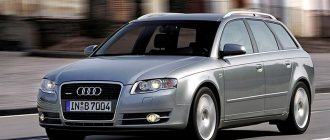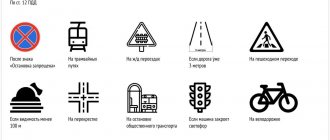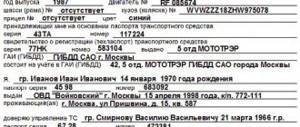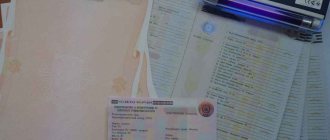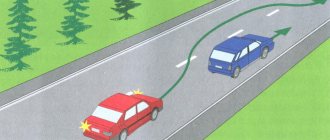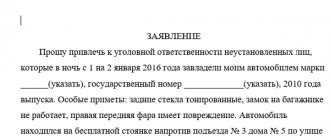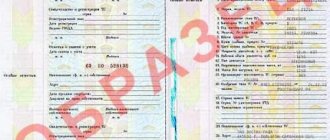What does the environmental class of a car show?
At the beginning of 2021, St. Petersburg took second place in the country in the anti-rating of cities with the dirtiest air - and this taking into account that the city has a small number of industrial facilities. The reason is the large number of cars that poison the air with exhaust gases.
What does the environmental class of a car show?
The European standard, which obligated manufacturers to modernize models and established a certain environmental class for the car, significantly reduced the amount of emissions into the atmosphere, but did not completely solve the problem. What is the environmental class of a car and what does it affect?
It is estimated that one average car per year with a mileage of 10,000 km consumes 4,100 kg of oxygen from the atmosphere and emits more than a ton of toxic substances, including lead, carbon monoxide and its compounds, sulfur dioxide, etc.
The environmental class of a car is a conditional gradation that reflects the amount and intensity of toxic waste that the car emits into the air. Today, automakers are required to comply with environmental standards and equip their vehicles with technologies and devices that reduce toxic emissions.
All vehicles today have a certain eco class or Euro standard, which depends on:
- year of production;
- fuel used;
- model, brand, country of origin;
- the presence of filter systems in the design.
Taking this into account, the car is allowed or prohibited to be used on the roads, brought into the country, crossed green areas, etc.
In 2021, the maximum environmental class for the Russian Federation is fifth.
What is a car’s environmental class and how many are there?
The European environmental class (EC) or Euro standard is a gradation of vehicles that reflects the amount of a number of substances, namely carbon monoxide, hydrocarbons and nitrogen oxide (CO, CH and NOx), emitted into the atmosphere by gasoline and diesel engines.
The first environmental standard introduced in Europe (1988) was Euro-0, and it applied only to gasoline engines and, in fact, determined the best indicators at that time, without regulating or limiting manufacturers.
If we express it in numbers, this means that during 3 months of operation in standard mode, the car consumes about a ton of oxygen, and the exhaust will produce about:
- 200 kilograms of carbon monoxide;
- 50 kg carbons;
- about 10 kg of nitrogen oxides.
Just 4 years later, a new standard appeared - Euro-1, which assumed that the production and import of cars in the countries where it received legal force would be carried out in compliance with somewhat stricter criteria.
Plus, to the listed substances, an indicator was added for the content of solid particles - soot - in the exhaust gases, and its effect extended to both gasoline and diesel internal combustion engines. Starting with the Euro-5 standard, the mass fraction of organic volatile substances was added to the mandatory criteria for determining the environmental class of a car.
The highest possible eco-standard
Subsequently, the standard was regularly updated - the permissible value for each indicator or individual types of emissions was reduced.
Today, the most stringent requirements are imposed according to Euro-6 standards, adopted in 2015. However, it is currently only valid in a few EU countries, and is rather advisory in nature.
At the same time, many manufacturers (including Russian ones) of engines, exhaust systems, fuel supply systems and filters, that is, those products that together will determine the final characteristics of the car, already produce goods that meet this standard.
Separately, there is the concept of environmental fuel class - although no one prohibits the production of gasoline or fuel of lower quality, you need to understand that its use will affect the final exhaust characteristics!
Its main criteria are the amount of sulfur in the composition, as well as the volatility of the product, that is, this indicator is already interconnected with the latest Euroclass standards. Accordingly, by filling in gasoline or diesel of a lower standard than that of the car, its owner affects the actual emissions values and accelerates the wear of the equipment itself.
History of Euro certification
By the beginning of 1990, the purity of the atmosphere on the planet had catastrophically decreased. Cars running on gasoline and diesel engines were recognized as the most harmful to the environment. In 1992, a special regulation was developed in Europe, called the protocol for limiting the level of atmospheric emissions from road transport.
The first protocol was called Euro-1; the document specified the parameters of toxic emissions that were allowed to be emitted by cars.
Russia is a signatory to the Convention on Road Traffic adopted in Geneva. All restrictions prescribed in European environmental standards apply on the territory of the country.
The protocol is reviewed annually and the amount of permissible emissions is reduced. When developing the protocol, the following substances that constitute the concept of “vehicle emissions” are taken into account:
- Particles included in exhaust gases.
- Evaporation from a specific type of fuel.
Ecological car class for entry into Europe
In Europe, there are widespread ecological zones that are restricted for cars with low-emission engines to enter. As a rule, heavy trucks and diesel-powered buses most often fall under such bans, but throughout the rest of the territory there are no additional requirements or bans.
- Without entering such an ecological zone, in European countries you can drive a car of any age, environmental friendliness index, or any type of fuel.
- Similar “clean” zones have long been defined in countries such as Austria, Belgium, Germany, Denmark, Spain and France. In the coming years, the Czech Republic will also join them.
- The Germans have determined the permissible entry into the ecological zone for cars, starting with the Euro 4 . Euro 1 are limited almost everywhere , and less often – Euro 3 . The Belgians are more loyal and if the car has a gasoline engine of a class lower than Euro 1 and a diesel engine lower than Euro 3, they can allow the car into the “clean” zone subject to additional payment.
- In Austria, Denmark and Spain, there are several options for environmental zones within the country, which have their own restrictions - in some places all cars are allowed, and entry is denied to trucks with an environmental vehicle class below Euro 4 .
How many environmental classes are there for a car?
- The first standard by which cars equipped with a gasoline engine were classified, Euro 1, began to operate in Europe in 1992. The protocol set minimum emission requirements. In the Russian Federation, the Euro-1 standard worked until 2005.
- The Euro-2 protocol was developed for EU countries in 1995; in the Russian Federation, the standard began to operate in 1999, along with the Euro-1 protocol. According to the protocol, the permissible level of emissions into the atmosphere was reduced by 100%, and fuel evaporation standards were tightened by 50%. Today, there are practically no cars with such a level of emissions - the engines are either recycled or modernized to a minimum percentage of emissions.
- The Euro 3 standard operated in the EU until 2004. The regulations included standards for both gasoline and diesel engines. For Russia, the protocol remained valid until 2013.
- Euro 4 was next. New amendments to the environmental class standard for cars were adopted in 2005. The Russian Federation joined the protocol in 2010. The standard tightened the amount of emissions and reduced the emission allowance standards by 40% compared to the previous protocol. Euro-4 was in effect in Russia until 2021. According to the standard, vehicles with an environmental safety class lower than Euro-4 could not be imported into the country. Manufacturers were required to upgrade engines in accordance with the protocol. Maximum emission standards for Euro 4:
- carbon dioxide - 4 g/km;
- carbon compounds - 0.55 g/km;
- solid carbons - 2 g/km.
- Euro-5 is the latest eco-standard that has been in force in the Russian Federation since 2015. European countries have been using the regulation since 2008. From 2021, the import of cars lower than Euro 5 into the country is prohibited.
Toxic emissions from cars into the atmosphere
Today there are restrictions on the entry onto public roads of cars whose environmental class is lower than that established for a certain zone. To increase the current eco class of a car, you need to:
- legally convert the engine;
- obtain an environmental inspection certificate;
- make appropriate amendments to the vehicle documentation at the State Traffic Safety Inspectorate.
Read more about environmental classes of cars in Russia
In the Russian Federation, the introduction of new environmental standards occurs much later than in Europe. Until now, on the roads of our country you can find cars that do not meet even the very first Euro 1 standard. Most often, the reason is that the environmental class is simply not specified in any documents. The situation is better in Moscow, where there is a restriction on the entry of cars of low environmental class.
How many cars are there in Russia that meet the most stringent safety standards? These include foreign-made cars starting in 2014, as well as domestic cars produced in 2021 and later. This is due to the fact that manufacturers are focusing on the newer environmental class of the car and producing cars that could comply with rules that have not yet been adopted.
Russian cars with a fourth safety class can still be used in the country without any restrictions. This means that it is worth upgrading such cars only if you are going to travel to European countries.
Why might you need an environmental class car?
You will need to find out what environmental class a car has if the model is bought abroad, imported into the country, or if you need to clear customs of a vehicle that has already been imported into the state.
Also, the constituent entities of the Russian Federation establish their own rules for collecting transport tax. The tax rate depends on the vehicle category, year of manufacture, and environmental class. There is no single tax rate in the Russian Federation; each region sets its own transport tax amounts.
In the transport tax return, line 110 in section 2 is reserved for indicating the environmental class. In addition, to accurately determine the environmental class of the car you will need:
- To understand which roads you can travel on legally.
- Is it necessary to convert the exhaust system to a higher one?
The exception is transport, which is considered self-propelled vehicles, i.e. The maximum speed of such a vehicle does not exceed 40 km/h.
Determination of the environmental class of cars and self-propelled vehicles.
So, you are faced with the need to find out the environmental safety class of a car before purchasing it and clearing it through customs, in order to decide whether it is advisable to import it or not. To begin with, we will provide you with an information table of the approximate dependence of the environmental safety class on the year of manufacture and country of origin. We draw your attention to the fact that the table does not provide unconditional guarantees of compliance, but the information provided in it is as close as possible to existing compliance standards.
| Obtaining opinions on the environmental class of vehicles and self-propelled machines | in St. Petersburg |
| in Kaliningrad | |
| in Murmansk | |
| in Pskov |
| Country of origin of the vehicle | Years of vehicle production, inclusive: | |||
| Not meeting the requirements of technical regulations at the time of import into the Russian Federation ( EURO 1 and below ) | Complying with the requirements of technical regulations, according to the environmental safety class of the vehicle | |||
| EURO 2 | EURO 3 | EURO 4 | ||
| Member of the European Union (list of EU member states). Gasoline engines | Until 1996 | 1997-2000 | 2001-2004 | Since 2005 |
| Member of the European Union Diesel engines | Until 1996 | 1997-2001 | 2002-2004 | Since 2005 |
| USA | Before 1995 | 1996-2000 | 2001-2003 | Since 2004 |
| Japan | Until 1997 | 1998-2004 | 2005-2010 | Since 2011 |
| Canada | Until 2000 | 2001-2003 | Since 2004 | ~ |
| India | Before 2004 | 2005-2009 | Since 2010 | ~ |
| Malaysia | Until 2002 | Since 2003 | ~ | ~ |
| China | Until 2003 | 2004-2007 | Since 2008 | ~ |
| Korea | Until 2000 | 2001-2002 | 2003-2005 | Since 2006 |
| Ukraine (category M) | Before 2005 | Since 2006 | ~ | ~ |
| Ukraine (category N) | Until 2006 | Since 2007 | ~ | ~ |
- EURO-5 . This standard was adopted by the EU back in 2008, and “came” to Russia only in 2021. However, at first Euro5 in the EU was applicable only to trucks. It took a year and a half for it to become mandatory for passenger cars. The standard also provides for control over the fuel that cars are filled with. Frequent inspections at EU petrol stations have forced unscrupulous suppliers to leave the market.
- EURO-6 . It became mandatory in Europe in 2021. Moreover, without particularly affecting gasoline engines, it hit diesel engines hard in terms of tightening requirements. Permissible NOx emissions decreased from 2 to 0.4 g/kWh, that is, more than three times.
The list of EU member states can be found at this link.
Now about the authorized centers for determining the environmental class of vehicles. The class is determined and a certificate is issued by authorized certification bodies. Customs, when clearing commercial vehicles, for which upon import a mandatory fact is compliance with the current eco-safety class (remember that from January 1, 2014 this is Euro 5 ) pays attention to:
— data in OTTS (Vehicle Type Approval). This document is issued by the vehicle manufacturer or its official representative;
| How to read the VIN number correctly (click on photo to enlarge) |
— data in the certificate of compliance with the requirements of the technical regulations “On the requirements for emissions of harmful (pollutant) substances from automotive vehicles put into circulation on the territory of the Russian Federation,” which is issued for a specific vehicle (the VIN of the vehicle body must completely match the VIN specified in certificate). Such certificates are issued only by certification centers accredited by the Federal Agency for Technical Regulation and Metrology of the Russian Federation.
Note - if you decide to independently determine the eco-standard of a vehicle based on a database from the website of Rosstandart or the Federal Customs Service, then it is better to abandon this idea - nowhere is it stated that this information can be appealed during customs clearance. These databases are used purely for informational purposes and it is impossible to prove otherwise.
You must also remember - if you import a vehicle that does not comply with the Euro 5 standard, and plan to use it on public roads - you will not sell it except for spare parts - you simply will not be given a title. The exception is bulldozers and excavators, which are used exclusively on construction sites and, as it is believed, cannot cause damage to the environment (in my opinion, this is a controversial statement). In general, this category includes vehicles for which not a PTS, but a PSM (Self-Propelled Vehicle Passport) is issued; they either do not move under their own power, or move, but at a speed of no more than 40 km/h. Find out more detailed information from customs brokers or by selecting the type of vehicle you are interested in in a special section of our website dedicated to customs clearance of special equipment.
Letter N 01-06/13081 can shed light on the issue of general standards for determining the date of manufacture of a vehicle, however, as we mentioned above, only the manufacturer can provide accurate data on the date of manufacture of the vehicle.
The environmental class for a self-propelled vehicle does not matter during customs clearance, since the PSM is issued, not the PTS, however, both customs brokers and certification centers can give you the necessary conclusion about the eco-standard class. If you have a precisely defined code for a self-propelled vehicle, determined in accordance with the Commodity Nomenclature of Foreign Economic Activity of the Customs Union (determined by a qualified professional in the field of customs, and not “by eye”), then it will be more profitable to contact certificate holders, if the class is not known - it is better to request the services of a broker in your region - this way you will avoid the possibility of incorrectly entering the code when receiving the certificate and this piece of paper will not have any force.
As for certification centers, there are them in any major city; you can also use the services of certificate providers from other cities (this is if their prices are more interesting to you). The main criterion for their work is the speed and quality of order execution, because mistakes are unacceptable - one typo in the certificate can cost a lot of money due to the longer placement of the vehicle at the temporary storage warehouse.
Let us remind you once again that when clearing vehicles through customs, most beginners use the services of customs brokers. Simply because it’s usually more convenient and the nerves remain in order. Specialists thoroughly check all documents before submitting them to customs, downtime at the temporary storage warehouse is practically reduced to zero (if the documents are in order), and release occurs remotely - through the use of Electronic Declaration systems. You can always request the cost of customs clearance services for special equipment through this form on our portal. A company manager from your city will answer you.
| Request for the cost of brokerage services and calculation of payments to customs |
Artyom Protasov NWFD-online
How to find out the environmental class of a car
There are several ways to check the environmental class of your car:
- study PTS;
- registration certificate;
- by VIN;
- through online services of government agencies.
According to STS
Only owners who have a new type of document in their hands have the opportunity to find out the environmental class of a car from the car’s registration certificate. In the new certificates, the environmental class is written in letters in the corresponding column; drivers comply with the requirement of signs 5.35. 5.36, 8.24 (passage of cars of the corresponding eco class).
Owners of the old certificate must exchange the STS, the effect of restrictive signs will apply to them from July 1, 2021.
According to vehicle title
In the PTS of the new model, the environmental class of the car is indicated in the 13th position. In old-style documents, the parameter may be on a different line; for some, the auto class is not set. In this case, the car is assigned a zero standard or Euro-1.
Through Rosstandart
The Rosstandart portal provides detailed data on manufacturers and summary tables of vehicle eco-class compliance by country and year of manufacture. Just go to the service and view the information you are interested in.
“Green” cars – saving the environment
In addition to the table by country and manufacturer, the service provides vehicle characteristics by make and model. The motorist needs to open the “Approval Information” page, enter the model and view the characteristics of the vehicle.
For example, for the Audi A8 the approval number is CU RU E-DE.AYA04.00070.P5I1, assigned Euro-5.
By VIN code
An effective option remains to check a specific car by VIN code through the environmental classes of Rosstandart cars. An electronic database for vehicle owners is provided on a separate page. 17 code characters are entered into a separate window; after a few minutes, the car owner receives detailed information on the model indicating the environmental class of the car.
If the manufacturer has not entered data on the emission standards that are present on a particular car, you must contact the State Traffic Safety Inspectorate with an application to assign a specific eco class after upgrading the car.
Ecological car class from 2021
Next, we will talk about how traffic rules will change due to new laws from July 1, 2021 and from July 1, 2021. It is planned to introduce a number of new road signs that will one way or another restrict the movement of cars with a high content of harmful substances in their exhaust.
The first stage involves the introduction of signs into operation, and the second - the expansion of the list of cars that will be subject to the designated prohibitions.
- Group of signs “Zone with environmental class restrictions”
In July 2021, the following signs will begin to appear on the roads:
Next to signs 5.35 and 5.36 you can also see sign 8.23, warning about the presence of video recording:
- Valid from July 1, 2021 (if the certificate contains an environmental class mark)
Let's figure out how to interpret each of these signs:
5.35: Passage is prohibited for all vehicles whose environmental class is lower than that required by the sign.
Above you can see an example of such a sign. The minimum environmental class of the car in this case is fourth. Accordingly, cars of the first, second and third classes are prohibited from driving in this zone.
5.36: Similarly establishes the minimum environmental class for trucks, tractors and self-propelled vehicles. Passage is prohibited for vehicles with a lower class.
- Valid from July 1, 2021 (if the certificate does not contain information about the environmental class)
5.35: Passage is prohibited for all vehicles whose environmental class is lower than that required by the sign. This restriction also applies to vehicles whose documents do not say anything about the environmental safety class.
That is, theoretically, in 2021, this ban could affect even a car with the highest environmental class. If the car was purchased before 2010, then the information about the environmental class was not entered into the STS. Having the necessary information in the PTS will not be enough: the car will still be prohibited from entering under this sign.
5.36: Similarly establishes the minimum environmental class for trucks, tractors and self-propelled vehicles. Passage is prohibited both for vehicles with a lower environmental class, and for those whose class is not indicated in the documents.
Signs 5.37 and 5.38 will be installed where prohibitory signs 5.35 and 5.36 end:
- Exceptions for “Zone with Environmental Class Restriction” signs
It is worth noting that a number of vehicles can ignore the prohibition signs 5.35 and 5.36. Among them:
- armed forces vehicles;
- police cars;
- rescue vehicles;
- ambulances;
- emergency transport;
- postal machines with a white diagonal stripe on a blue background on the side surface.
Regardless of what class such a car has and whether it is indicated on the certificate, its movement still cannot be limited by any of the new road signs.
- Vehicle environmental class plate
Also in 2021 a new plate 8.25 will appear:
It can be seen along with a number of familiar signs:
And also with signs:
The signs above are divided into two groups because, when combined with each group, the sign should be understood differently. We will explain this in more detail below.
- Valid from July 1, 2021 (if the certificate contains an environmental class mark)
If you see such a sign next to the sign, then the effect of the signs applies to cars with a lower environmental class than indicated on it.
For example, if the sign has the number 4, then the sign may prohibit (or, conversely, allow) turning for those cars that belong to the first three classes.
Here the meaning will be exactly the opposite. A sign allowing parking in combination with a sign means that only cars of the specified or higher class can stop here.
That is, if you see the number 4 on the sign, then parking is permitted for cars with fourth and fifth environmental safety classes.
- Valid from July 1, 2021 (if the certificate does not contain information about the environmental class)
The principle of operation of the signs remains the same, but their effect will also apply to all vehicles whose certificates do not indicate an environmental class. For example, this sign prohibits turning all cars of the first, second, third, as well as those not installed in the STS class.
From 2021, this combination should be understood as follows: if the environmental class is equal to or greater than the number on the plate, and also if the environmental class is not indicated in the STS, then such a car can park under this sign.
We can say that in this case the restrictions are not tightened, but, on the contrary, softened. If from July 2021 to July 2021 parking under this sign is prohibited for cars with an unknown environmental safety class, then from 2021 it will be allowed.
- Table of actions of signs with environmental class
The table below briefly and clearly explains how the new signs will operate from 2021 and what will change in 2021:
- Fines for violating the requirements of environmental road signs
At the moment, the Administrative Code does not have separate articles relating to violations of the requirements of environmental legislation and environmental road signs in particular. But violators can be fined in accordance with Article 12.16 of the Administrative Code:
12.16 Part 1: warning or fine in the amount of 500 rubles for all violations, except those indicated separately.
12.16 p.2: fine from 1,000 to 1,500 rubles for violating the requirements of a sign prohibiting left turns.
12.16 p.6: 500 rubles for driving trucks with a prohibitory sign (throughout the country, except Moscow and St. Petersburg).
12.16 part 7: 5,000 rubles for a similar violation committed in Moscow or St. Petersburg.
I would like to separately note that the presence in the registration certificate of the environmental class of a passenger car from 2021 will become a key parameter determining whether certain restrictions apply to it. Therefore, car enthusiasts should now think about the need to replace the STS if it does not have the corresponding column.
Fines in the Russian Federation for violating the standard
Today in the Administrative Code there is no article regulating the compliance of a vehicle with one or another eco class. Violators of environmental parameters are fined according to the list of parts of Art. 12.16 Code of Administrative Offenses, “Failure to comply with the requirements prescribed by traffic rules.” Namely:
- Violation of the “Left Turn” sign, Art. 12.16 p.2 fine – from 1000-1500 rubles.
- Movement of freight transport in the presence of a “No passage” sign, Art. 12.16 p.6., fine – 500 rubles. (except Moscow and St. Petersburg). If the violation occurs within these cities, the fine increases to 5,000 rubles.
- Art. 12.16 part 1 indicates that for any violation of the requirements of road signs, the driver will face either a warning or a fine of 500 rubles.
From 2021, the environmental class of a car will become a decisive factor in possible restrictions when driving on roads of a certain category. Car owners are recommended to replace the STS with a new document now and purchase cars on the secondary market that are at least Euro-4.
What does it mean that the car’s environmental class has not been established?
- As a rule, the environmental class of the car is indicated in the PTS. However, such a column appeared in this document only in 2006, when new technical regulations regarding emissions came into force.
- In this regard, it is generally accepted that the absence in the registration certificate of information about the assignment of an environmental class to the car’s engine means that this class is simply unspecified. And there are many such cars in Russia.
- In order to enter such data into the registration certificate, appropriate expertise is required. It is carried out at the NAMI testing center, which has the appropriate accreditation.
How to change the environmental class of a car in the PTS?
- If you do not know the environmental class of the car, you should contact an authorized dealer and find out this question. If the class meets the requirements, you will receive a document in the form of a certificate confirming the approval of this type of car. And then you go to the traffic police and put the appropriate mark in the PTS.
- If the environmental safety class does not meet the standard, then it is possible to re-equip the machine so that the concentration of prohibited substances is reduced. This can be done in certified companies, since you will need to provide the issued document on conversion to the traffic police.
- The environmental class could be lowered as a result of the fact that during operation certain engine parts could be worn out or replaced. In this case, you need to bring all components and parts into compliance.
- And finally, you can refer to the fact that the legislation does not currently require a mark in the vehicle title indicating that the car belongs to a certain environmental class. True, very soon this option will become problematic.
Change class
Rosstandart: how to find out the environmental class of a car and truck by VIN online?
- The VIN code is usually indicated on one of the parts of the car: either on the engine, or on the body pillar, and maybe on the lower part trim, or on the door sill. In any case, this information is indicated in the PTS.
- To find out which environmental safety class your car belongs to, you should use the information provided on the official website of Rosstandart, in the relevant requests section.
- You will need to enter the numbers of your VIN code, and you will be able to find out not only what environmental class the car belongs to, but also many other data, for example, what type of car is yours, its make, when the document was issued and how long it is valid.
- If this method does not help you, there is only one way out - contact the traffic police and conduct an examination.
Code
